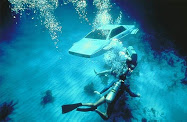Back in the 1960s, Ric O’Barry trained dolphins for the Flipper television show. He now blames himself for single-handedly kick-starting the worldwide ‘dolphin-arium’ business: “I’ve spent 10 years building this industry up, and the last 35 trying to tear it down.” But O’Barry doesn’t target the large American tourism giants like Seaworld – his focus is almost exclusively on one small fishing village in Japan by the name of Taiji.
Enter former National Geographic photographer and first-time filmmaker Louise Psihoyos. Once aware of the importance of the film’s titular location, Psihoyos assembles a crack-team of specialists to head to Taiji with a view to documenting and exposing some unsettling and horrific events. At one stage even Industrial Light & Magic are enlisted to create covert cameras to assist Psihoyos’ team (a sequence featuring a brief behind-the-scenes look at George Lucas’ special effect studio, and - much to my amusement - a blink-and-you’ll-miss-it glimpse of the ‘Vigo the Carpathian’ painting from Ghostbusters II, propped up against the wall of a junkyard).
Psihoyos’ film plays like an environmental espionage thriller, and there are definite echoes to James Marsh’s 2008 Oscar-winning documentary Man On Wire - another film where the thrill of the chase is almost the equal of the catch. However, Marsh’s film was hampered by its dramatic re-enactments, and further still on the (unfortunate but beautifully handled) reliance of still photographs to reveal Philippe Petit's final glory over the World Trade Centre. Psihoyos doesn’t have any such limitations, and The Cove is a far more visceral experience as a result.
Where Man On Wire was careful to avoid direct reference to the man-made atrocities surrounding the location of Petit’s tightrope climax, The Cove pulls no punches in showing us the brutal and unsettling horrors that a small Japanese community undertake to supply the world’s aquariums with dolphins and the uninformed Japanese people with what they believe to be whale-meat.
The Cove is not an easy film to watch – in fact, it’s terrifying – and due to Japan’s stance on whaling, it looks unlikely that the practices unearthed here will change at any time in the immediate future. Only with a snowball effect by way of word-of-mouth can the film reach a larger audience, and only then can any action be hoped for. Critics may argue that there are far larger issues to deal with, but as Psihoyos himself points out, “how can we expect the bigger stuff to get sorted out if we let things like this happen?”
Pass it on.


No comments:
Post a Comment